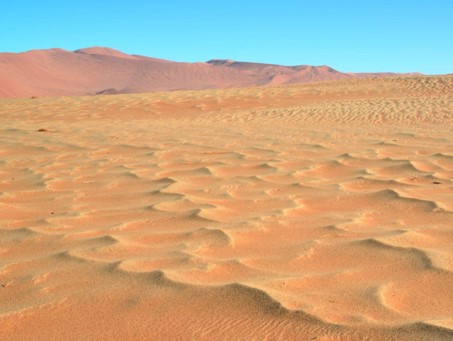Dwarf Dunes Record Climate History in Desert Sand

Unexpected relationship: Megaripples and sand dunes Foto: Dr. Hezi Yizhaq
Sandy deserts aren't smooth. Like water surfaces, they are decorated by tiny surface ripples and much larger waves, called dunes, excited by turbulent winds. Now, writing in Nature Physics, an international team of geomorphologists and physicists elucidates the physical mechanism creating a third type of sand wave, with no marine analogy.
These curious “megaripples” resemble large ripples but have long eluded a mechanistic understanding and clear phenomenological characterization. Not surprisingly—the authors say—as they are actually dwarf dunes.
The new perspective might be key to deciphering their morphological long-term memory of ambient soil and weather conditions, and provide interesting new directions for geomorphological analysis and remote sensing applications to related bedforms seen on Mars, for example.
The starting point of the study was a closer look at the conditions under which megaripples form. Turbulent winds not only create sand waves, they also sort grains by size. Fine grains advance quickly while coarser grains trail behind. For this reason, sand found in large dune fields—having been transported for miles by the wind—is typically composed of grains that are all about the same size.
In contrast, megaripples contain grains of all different sizes. Under erosive conditions, the fine grains leave while coarser grains, which are too heavy to be mobilized by the wind, gradually accumulate on the sand bed.
This sets off a special bimodal transport process, in which the impact of high flying fine grains helps the coarse grains to advance in tiny steps. Their drastically reduced hop length prompts a corresponding downsizing of the dunes they form.
As Marc Lämmel et al. now demonstrate, this new interpretation of megaripples as mini-dunes of coarse grains is supported not only by the known co-localization of megaripples and coarse grains. It is quantitatively corroborated by close morphological and dynamical similarities between megaripples and ordinary sand dunes, which had remained unnoticed because of the enormous difference in size.
An important implication of the new work is that megaripples are extraordinarily sensitive to fluctuations in grain-size and wind-strength. It explains why megaripples stop growing during periods of weak winds and quickly erode during storms. What has plagued systematic field studies in the past, now renders megaripples perfect candidates for retrodicting past weather and climate conditions.
How their morphology and grain composition encodes records of past sorting and growth phases reminds one of the growth rings in tree trunks. If judiciously interpreted, petrified or extraterrestrial megripples,
say, will reveal valuable information about the climate history.
While further research is needed to establish a reliable routine for deciphering the messages in the sand, nothing prevents you anymore from embarking on this endeavor yourself, equipped with spade and sieve, on your next beach or desert trip. Before you set off, here is the portable version of the theory for analyzing your data: megaripples are mini-dunes of mega-grains making mini-jumps.
ORIGINAL PUBLICATION:
Marc Lämmel, Anne Meiwald, Hezi Yizhaq, Haim Tsoar, Itzhak Katra, and
Klaus Kroy:
“Aeolian sand sorting and megaripple formation”
Nature Physics (2018) Advance Online Publication (AOP)
Contact:
Prof. Dr. Klaus Kroy
Institute for Theoretical Physics, Leipzig University, Germany
Telefon: +49 341 97-32436
E-Mail: klaus.kroy@itp.uni-leipzig.de
Media Contact
More Information:
http://www.uni-leipzig.deAll latest news from the category: Earth Sciences
Earth Sciences (also referred to as Geosciences), which deals with basic issues surrounding our planet, plays a vital role in the area of energy and raw materials supply.
Earth Sciences comprises subjects such as geology, geography, geological informatics, paleontology, mineralogy, petrography, crystallography, geophysics, geodesy, glaciology, cartography, photogrammetry, meteorology and seismology, early-warning systems, earthquake research and polar research.
Newest articles

Long-sought structure of powerful anticancer natural product
…solved by integrated approach. A collaborative effort by the research groups of Professor Haruhiko Fuwa from Chuo University and Professor Masashi Tsuda from Kochi University has culminated in the structure…

Making a difference: Efficient water harvesting from air possible
Copolymer solution uses water-loving differential to induce desorption at lower temperatures. Harvesting water from the air and decreasing humidity are crucial to realizing a more comfortable life for humanity. Water-adsorption…

In major materials breakthrough
UVA team solves a nearly 200-year-old challenge in polymers. UVA researchers defy materials science rules with molecules that release stored length to decouple stiffness and stretchability. Researchers at the University…



